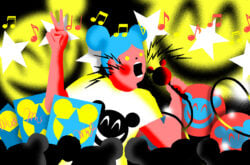Illustration: Franco Égalité
In October of 2021, our colleague Christina Lee formed the Art Appropriation Council at Splice with voices from our Content, Music, and Marketing teams.
Their intention was to arrive at a shared understanding of cultural appreciation vs. cultural appropriation, and use that shared understanding to ensure the artwork on Splice was inclusive, collaborative, and truly representative of culture and music.
As we continue to grieve the loss of our beloved Christina, we’re moved to share this work and ensure it’s seen as widely as possible. Christina’s vision was that this guide would have legs outside of Splice, and be seen as a new standard across the wider music industry. She discussed wanting to make this framework publicly available and open to ongoing review and evolution, and she felt strongly that the work should continue to develop with culture.
We are incredibly proud of what Christina accomplished and proud to have worked with her every day. We hope next time you release or embark on a project, you might consider also referencing this framework to guide yourself around what could be considered appropriation rather than appreciation.
How it started
We state in our quality principles that “Splice is committed to maintaining a platform that’s respectful to musicians of all kinds, ages, and backgrounds who come to find inspiration.”
As a team, we’re constantly trying to find solutions for things in our environment, and we recently decided to formalize frequently brought up discussions about submissions for pack art. As our submission pool has grown and our processes have matured, we became keenly aware of patterns of cultural appropriation that directly conflict with those principles.
The music industry has a beautiful history of cultural appreciation and a notorious history of cultural appropriation. Our intention became to consistently and transparently interrupt that pattern. To do this, we decided we needed a framework to help evaluate the hundreds of visual pack art submissions we receive each month.
“Cultural appropriation has been an issue my team and I have been working to address with third-party labels since I first started working at Splice back in 2018. Back then, it was even more of a wild west because the industry had zero guidelines and best practices around quality.”
—Ayesha Chugh, Sr. Manager, Creator Relations
Appreciation vs. appropriation
There is a tricky gray area between these two ideas. Splice considers cultural appropriation to be the unacknowledged or inappropriate adoption of an element of one culture by someone who is not a part of that culture through lineage or heritage.
Industry-wide, this isn’t a new topic. There is a long history of artists appropriating cultures by acting out stereotypes.


The guide
Below is a guide we now use internally when looking at artwork.
At Splice, we’re using it as a tool that allows us to normalize talking about this issue and improve our ability to address it when we see it. We don’t assume we’re getting everything right—rather, we hope our partners and customers will contribute feedback, and we intend to continually improve and update this work. We hope it’ll be a valuable resource in your own journey as a creative, too.
See the guide in its entirety here.
The 2022 Splice Art Appropriation Council:
- Ayesha Chugh, Sr. Manager, Creator Relations
- Gab Conte, Senior Counsel
- Dani DiCiaccio, VP, Content
- Shakeil Greeley, Art Director
- Ken Herman, Content Strategist
- Devon Johnson, Catalog Manager
- Matteo Malinverno, Director, Catalog
- Max Nepa-Rewak, Programming Lead, Studios
- Andrew Pearce, Catalog Manager
—and in memory of our friend, Christina Lee.
May 31, 2022



